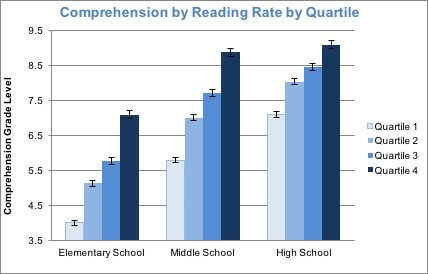
Purpose of Study:
When students must devote much of their attention to the process of reading, e.g., laboriously decoding words and deciphering word meanings, they are likely to have difficulty sustaining the level of attention that reading with good comprehension requires. These students are also likely to miss out on what motivates readers—being entertained, inspired and/or learning from what they read.
This study examined relationships between reading efficiency, reading comprehension, and reading motivation in a large national sample of students who had engaged in Reading Plus during the 2015-16 school year.
Study Design:
Students were divided into reading rate quartile groups based on their reading rate as measured by the InSight assessment, and using reading rate norms established for each grade in a national study of U.S. students (Spichtig et al., 2016). Students’ reading comprehension grade levels and reading motivation were also measured by the InSight assessment (see InSight Technical Brief for more information).
Key Results:
Comprehension grade levels varied significantly across reading rate quartiles. In all grade groups, students in higher quartiles (who read more efficiently) achieved significantly higher comprehension grade levels.
Reading interest also varied significantly across reading rate quartiles. In all grade groups, students who read more efficiently reported significantly higher levels of reading interest.
Reading self-efficacy (i.e. self-perceived reading competence) followed the same pattern as above. In all grade groups, more efficient readers reported higher levels of reading self-efficacy.

